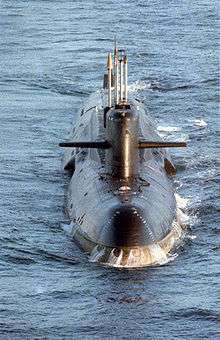RK-55
| RK-55 Granat (NATO reporting name: SSC-X-4 'Slingshot') S-10 Granat (SS-N-21 'Sampson') | |
|---|---|
|
RK-55 Transporter-Erector-Launcher | |
| Type | surface/sub-launched nuclear cruise missile |
| Place of origin | Soviet Union |
| Service history | |
| In service | 1984 |
| Used by | Soviet Union / Russia |
| Production history | |
| Designer | L. V. Lyulev |
| Designed | 1975 |
| Manufacturer | Novator |
| Produced | 1976 |
| Specifications | |
| Weight | 1,700 kg (3,750 lb) |
| Length | 809 cm (26 ft 7 in) |
| Diameter | 51 cm (20.1 in) |
| Warhead |
Conventional Nuclear |
| Blast yield | Nuclear 200kt [1] |
|
| |
| Engine |
Solid-propellant rocket booster + R-95-300 turbofan 450 kgf |
| Wingspan | 310 cm (122.0 in) |
Operational range | 3,000 km (1,600 nmi)[2] |
| Speed | 720 km/h (447.4 mph) |
Guidance system | Sprut inertial guidance plus TERCOM |
Launch platform | Akula-class submarine, Sierra II, Victor III, Yankee Notch, Yasen-class submarine, TEL |

The Novator RK-55 Granat (Russian: РК-55 Гранат 'Garnet'; NATO: SSC-X-4 'Slingshot'; GRAU: 3K10) was a Soviet land-based cruise missile with a nuclear warhead. It was about to enter service in 1987 when such weapons were banned under the Intermediate-Range Nuclear Forces Treaty. A version launched from submarine torpedo tubes, the S-10 Granat (SS-N-21 'Sampson'; GRAU: 3M10), has apparently been converted to carry conventional warheads and continues in service to this day.[3]
The RK-55 is very similar to the air-launched Kh-55 (AS-15 'Kent') but the Kh-55 has a drop-down turbofan engine[4] and was designed by MKB Raduga. Both have formed the basis of post-Cold-War missiles, in particular the Sizzler which has a supersonic approach phase.[5]
Development
In the late 1960s, the "Ekho" study conducted by the GosNIIAS institute concluded that it would be more effective to deploy lots of small, subsonic cruise missiles than the much more expensive supersonic missiles then in favour.[6] In 1971 Raduga began working on the air-launched Kh-55, which first flew in 1976.[4] That same year, RK-55 first flew.[5] NPO Novator would work on the submarine- and ground-launched versions. In 1993 Novator exhibited the Sizzler series weapons, which appears to be based on the RK-55.[5] It is a two-stage design, which goes supersonic during its final approach to the target.
Design
Six RK-55 missiles are carried on an eight-wheeled transporter-erector-launcher (TEL) based on the MAZ 543 launcher of the R-17 (SS-1 'Scud B').[7]
The S-10 is launched through 533 mm torpedo tubes.
Operational history
Fewer than 100 SS-N-21s had been deployed by the end of 1988.[2] The new Akula-class submarine, launched in September 1986, was the first class to receive the new missile.[8] It was later fitted to the Sierra I/II class and eight Victor III's and the new Yasen-class submarines.[8]
The Grusha-class submarine deployed in 1988[2] is a design of particular note, replacing the missile launchers on a ballistic submarine with tubes dedicated to large numbers of cruise missiles. They were probably nuclear-tipped RK-55's during the Cold War, and then converted to use conventional warheads for land attack[8] after the START I treaty restricted sub-launched nuclear cruise missiles. The US Navy has done the same on a grander scale with the SSGN conversions of four Ohio-class submarines. It has been suggested that RK-55's could in future be fitted to converted Delta class submarines, or to surface ships, but these have not been confirmed.[5]
The ground-launched variant was subject to the Intermediate-Range Nuclear Forces Treaty signed in December 1987 and had been tested but not deployed by that time.[9] 80 missiles had been destroyed by November 1990.[10]
Variants
- RK-55 (SSC-X-4 'Slingshot') - ground-based version
- S-10 or RK-55 (SS-N-21 'Sampson') - submarine-launched version
- SSC-X-8 (9M728 9M729)
Conventional unitary High Explosive (HE) warhead and submunition warhead versions of the RK-55 have probably been developed, to justify the continuing service of the submarines that carry them.[5]
Operators
Former
Derivatives
 India
India Iran
Iran North Korea
North Korea People's Republic of China
People's Republic of China Pakistan
Pakistan Republic of Korea Hyunmoo cruise missile .
Republic of Korea Hyunmoo cruise missile .
Similar weapons
- Raduga Kh-55 - originally thought in the West to be an air-launched version of the RK-55, now has tactical versions such as the Kh-55 and the stealthy Kh-101.
- UGM-109 Tomahawk - the Capsule Launch System allows Tomahawks to be fired from torpedo tubes or dedicated submarine launch tubes
- Ground Launched Cruise Missile (BGM-109G Gryphon) - land-based Tomahawk with tactical nuclear warhead of 10-50 kt and 2000–2500 km range
- Pershing 1b and Pershing II RR - 740 km range ballistic missile also in testing at the time of the INF Treaty
Notes and references
- ↑ SIPRI (1989) p16
- 1 2 3 Norris, Cochran; et al. (1989), SIPRI Yearbook 1989: World Armaments and Disarmament (PDF), p. 21
- ↑ CSIS Missile Threat - SS-N-21 (RK-55)
- 1 2 "Kh-55 (AS-15 'Kent'/Kh-555/RKV-500/Kh-65)", Jane's Strategic Weapon Systems, 2009-09-09, archived from the original on February 4, 2009, retrieved 2009-02-04
- 1 2 3 4 5 "RK-55 Granat (SS-N-21 'Sampson'/3M10)", Jane's Strategic Weapon Systems, 2008-09-10, retrieved 2009-02-04
- ↑ "Kh-55/RKV-500A, Kh-55SM/RKV-500B, Kh-555 and Kh-65SE (AS-15 'Kent')", Jane's Air-Launched Weapons, 2008-08-01, archived from the original on June 4, 2009, retrieved 2009-02-06
- ↑ "RK-55 (SSC-X-4 'Slingshot' and 3K10 Granat)", Jane's Strategic Weapon Systems, 2008-09-12, retrieved 2009-02-04
- 1 2 3 "SS-N-21 'Sampson' (P-1000 3M70 Vulkan/3M10 Granat)", Jane's Naval Weapon Systems, 2009-01-08, archived from the original on September 15, 2008, retrieved 2009-02-04
- ↑ Thomson, David B. (July 1999), A Guide to the Nuclear Arms Control Treaties LA-UR-99-3173 (PDF), Los Alamos National Laboratory, p. 131
- ↑ Thomson (1999) p127
External links
CSIS Missile Threat - SS-N-21 (RK-55)